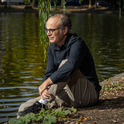Sandy Sullivan, an affable 65-year-old father of six from Glasgow, wants to revolutionise the global funeral business. And, in death, the late archbishop Desmond Tutu may just have given him a huge helping hand.
It was on 2nd January, the day after Tutu’s funeral, that Sullivan noticed his website, which normally registers 1,000 hits a month, was in something like meltdown. He traced the surge in interest to a piece in the Washington Post which name-checked the company while reporting on Tutu’s wish for his body to be dissolved by water rather than cremated by flames.
The Post reported that Tutu’s body had been duly liquefied under pressure via a process known as aquamation—an environmentally friendly alternative to expensive caskets and high-temperature cremation. And there, named in passing, was Sullivan’s company, Resomation, which he founded in 2007.
Sullivan, who studied biochemistry at Strathclyde University, had a background working in sterilisation technologies used to decontaminate and dispose of cattle infected with BSE (mad cow disease). And then it struck him: what worked with cows could also work with humans.
“When you bury a body, a big piece of the process that nature applies is actually alkaline hydrolysis that is carried out by soil bacteria using an enzymatic process. The process of breaking up the soft tissue is actually a hydrolysis. It’s a long, slow process—months, years even, depending on the soil,” he told me. “We’ve speeded it up to around four hours from the body going in, to the bones coming out. When you increase the heat—to about 150 degrees centigrade—you increase the speed.”
“It’s about the rebirth of the human body, as opposed to effectively destroying all the nutrients in the body”
The body is typically placed in a Resomator machine in a woollen shroud. At the end all that’s left are whitened bones, which are dried and ground to powder to be handed back to relatives, as with cremation. Oh, and any bits of metallic scaffolding—hips, knees et cetera—also survive, and can be salvaged and re-used.
Sullivan speaks with Messianic fervour about the environmental benefits of his machines, which sell for about £400,000 each. Unlike cremation, there are no gases or particulates released into the atmosphere: they can include sulfur dioxide and mercury from fillings. The sterile “slightly beige” waste water at the end of the process can be piped into drains, or even used on agricultural land. “There are no viruses, no bacteria: it’s mostly amino acids and salts. If you look at the human body, it’s high in nitrogen, phosphates and phosphorous, and they are three key plant feed elements and have the basics of being a good fertiliser.
“I called my company Resomation because it’s about the rebirth of the human body, as opposed to cremation, where you’re effectively destroying all the nutrients in the body. I was sitting downstairs at my table for about a week coming up with all these different names which I could also get a dot-com for. I hit on ‘Resomation’—‘re’ is from the Latin; ‘soma’ meaning body, with a Greek derivation; and ‘mation’ from ‘cremation.’
The method is, he says, now used in South Africa, Canada, Mexico and the US—and will shortly be available in the UK as well as Ireland and the Netherlands. But progress has been slow, due to regulation and because the funeral business is “a very protective industry, a very conservative industry, a very profitable industry.” Sandy digresses on the money to be made from recovering cremated gold and silver fillings and cobalt and titanium hip joints—though most of it, he says, goes to charity.
Jessica Mitford’s 1963 book The American Way of Death shook up the way we thought about the rituals and business around the funeral industry. Could it be that Sandy Sullivan and his Resomation machines will do the same in the 2020s? If so, it’s another reason to thank Demond Tutu.













